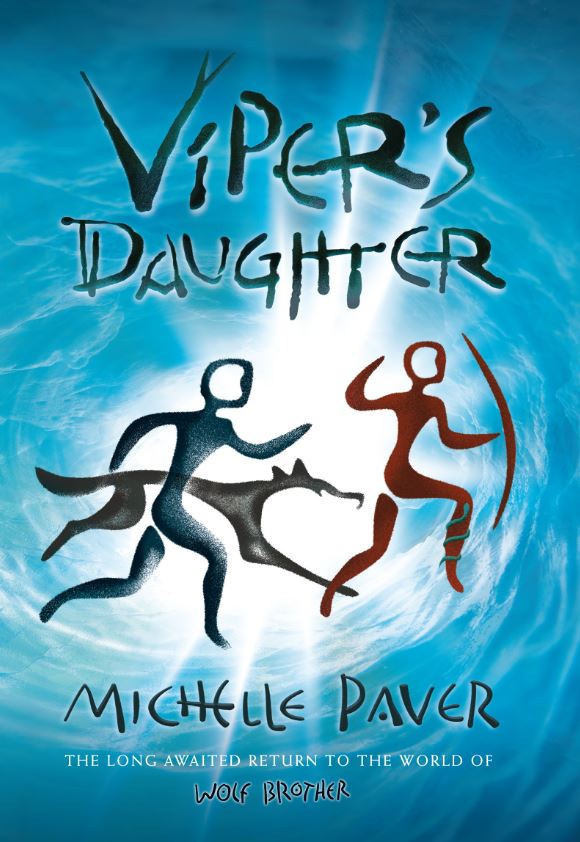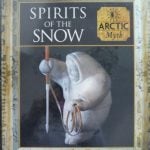We are honoured today to have Michelle Paver join Ian Eagleton in The Reading Realm to talk about her brand-new book, Viper’s Daughter. Michelle Paver is an international bestselling author with over 3 million copies of her books sold across the globe. She is known for her prize-winning, million-copy-selling
Wolf Brother series – a thrilling set of historical adventures full of mystery, magic and danger. After a hiatus of over a decade, we now see the return of Michelle’s beloved characters Torak, Renn and Wolf in Viper’s Daughter…

Without giving too much away, can you tell us about VIPER’S DAUGHTER, the seventh book in your award-winning series?
It’s an adventure about a boy, a girl and a wolf battling to survive in the Stone Age. Torak is the best tracker in the Forest, Renn is an amazing shot with a bow and arrow, and Wolf is a wolf: parts of the story are told from his point of view. The story starts when Renn realises Torak’s in danger – and she’s the threat. She leaves, and to find her, Torak and Wolf must trek north, to the Edge of the World…
I wrote it both for existing fans of the Wolf Brother books and for new readers who want a rich, immersive adventure in an entirely different world. And I do mean adventure! As with the other Wolf Brother books, my aim is to make the reader unable to put it down.
How did you feel about returning to the world of Torak, Renn and Wolf? Were you excited? Did you have any reservations?
I’d never planned to write another Wolf Brother book, but Torak, Renn and Wolf simply didn’t leave me. Also, fans of the books never stopped asking, “Please please can you write another one?” Then a few years ago I was in arctic Norway, trudging through the snow, when I saw the aurora borealis pointing north. That gave me such a strong idea for a story that I had to write it. As for reservations about returning to Torak’s world, I had none whatsoever, because I knew I had a great new story – and a stonkingly good villain.
How would you say your main characters Torak and Renn are similar? How are they different from each other? Did it take a long time to consider how they might have grown and developed over the years?
Both are brave, resourceful, and adept at surviving in the Forest: Torak with his tracking skills, Renn with her beloved bow. As to differences… Torak grew up apart from people, so he’s a loner, more comfortable with his beloved pack-brother Wolf than with people. He’s also a spirit walker, intensely aware of how different creatures experience life; and of course he speaks wolf! Renn is a member of the Raven Clan, so she’s more attuned to people. A reluctant Mage, she’d good at spotting hidden patterns and webs of causation.
As to how they’ve developed over the years, I didn’t find this hard, it was easy and fun, because I know Torak, Renn and Wolf pretty well, having lived with them for years while I was writing the first six books. Also, as I said, I’d never stopped thinking about them. And on re-reading the first six books, I realised there would quite a lot of emotional fallout for them to deal with.

The story begins with a mystery: we are plunged immediately into an adventure and trying to piece together why a main character has disappeared. Why did you decide to start the adventure like this?
I wanted a simple set-up that would appeal both to existing fans of the Wolf Brother books, and readers completely new to them. That’s why I kept the focus on Torak, Renn and Wolf: on the bonds of love and trust between them, and on how these are tested in the story.
There are some beautiful descriptions of the setting throughout: you wonderfully capture the menacing aspect of nature and I know you visited Norway, Iceland and Siberia as part of your research. Do you have a favourite experience you can tell us about while you were travelling and researching the book?
I was on an ice-breaker in the Bering Straits east of Siberia, and we came upon something extraordinary: a vast “island” of tiny voiceless black seabirds (shearwaters) feeding on krill being churned up by a pod of humpback whales far beneath. I was standing in the bow, hypnotised by these thousands of birds rising into the sky as one, then settling to feed, then rising again – when suddenly a whale surfaced with a “PSHEW!” so close to the ship that I feared we might hit it. For an instant I saw the water streaming from its smooth black blow-hole, and the whale’s brown eye met mine. Then it dived beneath the waves and was gone (narrowly avoiding a collision). I’ll never forget it. And of course I used it in Viper’s Daughter.
What really comes across in the book is the characters’ respect for and awe of nature. How do you think our relationship with the natural world has changed?
Torak and Renn are hunter-gatherers, which means that everything they need for survival – food, weapons, clothes, shelter – they’ve got to find or make from the natural world: animals, trees, plants, rocks. Thus they don’t take more than they need, and don’t waste any part of an animal they kill. By contrast, most of us have a much more distant relationship with the natural world, which obscures the fact that we depend on it every bit as much as Torak and Renn. I find that young people really love the “survival” aspects of the stories. As well as Wolf, of course.
I was fascinated by so many of the inventions throughout the story, the weapons and clothing especially – and it’s a testament to your meticulous research just how evocative and informative the story is. I loved the fact that Torak uses a strip of birch bark for an eye shield! How did you discover all these fascinating Stone Age facts and do you have a favourite? How difficult is it to balance all these aspects: the authenticity of the ancient past and the characters’ relationship and mindset?
I did lots of archaeological research into the Stone Age, but crucially, I “put flesh on the bones” by visiting people who still live in traditional ways: the Sami in Lappland, the Inuit in the Arctic, the Chukchi in Siberia, the clans of the Pacific Northwest. I’ve drawn on these for details of clothing, survival, the clans’ beliefs about life and death, healing and hunting. Obviously these aren’t “facts” about the Stone Age, but by studying more recent hunter-gatherers, I’ve tried to create an authentic Mesolithic world. And I’ve been delighted to find that the books have found favour with many archaeologists.
That said, only a tiny bit of all this research finds its way into the finished book: I don’t want to slow it down! Viper’s Daugher is an adventure. The little bits of research are there make the reader feel he or she is living the adventure with Torak, Renn and Wolf.
The story gallops along at a ferocious speed! It’s action packed and tense. What is the editing process like for you? What did you have to remove from or add to the story to ensure it kept its page-turning qualities?
I do masses of self-editing while I’m writing the book, which means that when my wonderful editor Fiona Kennedy finally sees it, there’s nothing structural that needs doing; although Fiona’s comments and suggestions are always invaluable. The editing process with her takes about three weeks. It’s mostly about adding little touches: bringing out Torak and Renn’s feelings, tightening scenes, clarifying. The aim is to make the story as evocative and full of action and emotion as I possibly can.
Do you have any book recommendations for primary school teachers who are teaching their children about the Stone Age?
That’s a tricky one. My bookshelves are full of rather academic volumes (The Mind In The Cave, Shamanism), which might be overdoing it for primary school pupils. Also I’m not a teacher, so I’m unsure what might help; but here are two books on Inuit myths and Arctic clothing that might be interesting, if teachers want to adopt an “ethnoarchaeological” approach, maybe as a change: Spirits of the Snow: Arctic Myth (Time-Life Books, 1999) and Arctic Clothing (The British Museum Press, 2005).
I was excited to see that the eighth book in the series will be published in 2021. Can you give us any clues about what’s going to happen?
Skin Taker starts in the Dark Time, when the sun is asleep in its cave. Something terrible happens to the Forest. Torak, Renn and Wolf are in the thick of it – and Torak is affected most of all. I can’t say more, as I don’t want to spoil it. What I can say is that, like Viper’s Daughter, Skin Taker is a standalone story (although there is a bit of a story arc, for those who’ve read Viper’s Daughter). The same goes for Wolfbane, to be published in 2022.
Finally, can you describe VIPER’S DAUGHTER in three words.
STONE AGE ADVENTURE. (Not very original, but you did ask for only three words!)
This slideshow requires JavaScript.





2 responses
My son (who is now at university) absolutely loved Michelle Pavers’ books when he was younger and we have the full set. They are amongst the many books he won’t let me put away in the loft or give to charity. Fond memories id seeing him absorbed in a book on the sofa 👍🏻
I absolutely love these books, and when i found out there where more coming out i couldn’t be more excited. Thank you for writing these amazing stories!